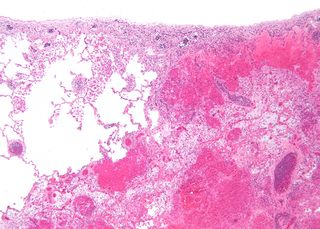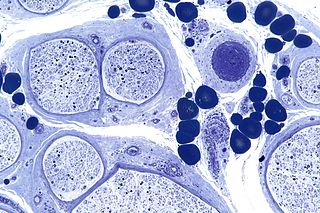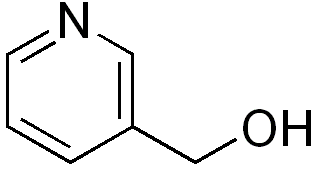Related Research Articles

The peripheral nervous system (PNS) is one of two components that make up the nervous system of bilateral animals, with the other part being the central nervous system (CNS). The PNS consists of nerves and ganglia, which lie outside the brain and the spinal cord. The main function of the PNS is to connect the CNS to the limbs and organs, essentially serving as a relay between the brain and spinal cord and the rest of the body. Unlike the CNS, the PNS is not protected by the vertebral column and skull, or by the blood–brain barrier, which leaves it exposed to toxins.
A peripheral device, or simply peripheral, is an auxiliary hardware device used to transfer information into and out of a computer. The term peripheral device refers to all hardware components that are attached to a computer and are controlled by the computer system, but they are not the core components of the computer.
Periphery or peripheral may refer to:

The American Heritage Dictionary of the English Language (AHD) is a dictionary of American English published by Boston publisher Houghton Mifflin, the first edition of which appeared in 1969. Its creation was spurred by the controversy over the perceived permissiveness of the Webster's Third New International Dictionary. The third edition included over 350,000 entries and meanings.

Peripheral vision, or indirect vision, is vision as it occurs outside the point of fixation, i.e. away from the center of gaze or, when viewed at large angles, in the "corner of one's eye". The vast majority of the area in the visual field is included in the notion of peripheral vision. "Far peripheral" vision refers to the area at the edges of the visual field, "mid-peripheral" vision refers to medium eccentricities, and "near-peripheral", sometimes referred to as "para-central" vision, exists adjacent to the center of gaze.

Cyanosis is the change of body tissue color to a bluish-purple hue, as a result of decrease in the amount of oxygen bound to the hemoglobin in the red blood cells of the capillary bed. Cyanosis is apparent usually in the body tissues covered with thin skin, including the mucous membranes, lips, nail beds, and ear lobes. Some medications may cause discoloration such as medications containing amiodarone or silver. Furthermore, mongolian spots, large birthmarks, and the consumption of food products with blue or purple dyes can also result in the bluish skin tissue discoloration and may be mistaken for cyanosis. Appropriate physical examination and history taking is a crucial part to diagnose cyanosis. Management of cyanosis involves treating the main cause, as cyanosis isn’t a disease, it is a symptom.

Infarction is tissue death (necrosis) due to inadequate blood supply to the affected area. It may be caused by artery blockages, rupture, mechanical compression, or vasoconstriction. The resulting lesion is referred to as an infarct (from the Latin infarctus, "stuffed into").

Peripheral neuropathy, often shortened to neuropathy, is a general term describing damage or disease affecting the nerves. Damage to nerves may impair sensation, movement, gland, or organ function depending on which nerves are affected; in other words, neuropathy affecting motor, sensory, or autonomic nerves result in different symptoms. More than one type of nerve may be affected simultaneously. Peripheral neuropathy may be acute or chronic, and may be reversible or permanent.

An adapter or adaptor is a device that converts attributes of one electrical device or system to those of an otherwise incompatible device or system. Some modify power or signal attributes, while others merely adapt the physical form of one connector to another.
An inotrope or inotropic is a drug or any substance that alters the force or energy of muscular contractions. Negatively inotropic agents weaken the force of muscular contractions. Positively inotropic agents increase the strength of muscular contraction.

In colloquial language, puffery refers to exaggerated or false praise. Puffery serves to "puff up" what is being described. In law, puffery is usually invoked as a defense argument: it identifies futile speech, typically of a seller, which does not give rise to legal liability. In a circular manner, legal explanations for this normative position describe the non-enforceable speech as a statement that no "reasonable person" would take seriously anyway.

Peripheral edema is edema in tissues perfused by the peripheral vascular system, usually in the lower limbs. In the most dependent parts of the body, it may be called dependent edema.

In geology, a depression is a landform sunken or depressed below the surrounding area. Depressions form by various mechanisms.
Bruit, also called vascular murmur, is the abnormal sound generated by turbulent flow of blood in an artery due to either an area of partial obstruction or a localized high rate of blood flow through an unobstructed artery.
Tendon reflex may refer to:

Vitality is the capacity to live, grow, or develop. Vitality is also the characteristic that distinguishes living from non-living things. To experience vitality is regarded as a basic psychological drive and, in philosophy, a component to the will to live. As such, people seek to maximize their vitality or their experience of vitality—that which corresponds to an enhanced physiological capacity and mental state.
The Anglo-French Wars were a series of conflicts between the territories of the Kingdom of England, its sequel United Kingdom and the Kingdom of France succeeded by a republic. Their conflicts spanned throughout the Middle Ages to the modern age. Those include the following.

Naftidrofuryl (INN), also known as nafronyl or as the oxalate salt naftidrofuryl oxalate or nafronyl oxalate, is a vasodilator used in the management of peripheral and cerebral vascular disorders. It is also claimed to enhance cellular oxidative capacity. The drug act as a selective antagonist of 5-HT2 receptors (with action as an inverse agonist of the 5-HT2A receptor specifically characterized). Naftidrofuryl is also licensed for the treatment of intermittent claudication due to peripheral arterial disease.

Nicotinyl alcohol (pyridylcarbinol) is a niacin derivative used as a hypolipidemic agent and as a vasodilator. It causes flushing and may decrease blood pressure.
References
- ↑ "American Heritage Dictionary". Houghton Mifflin Company. Retrieved 26 November 2013.The American Heritage® Medical Dictionary